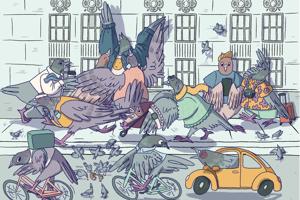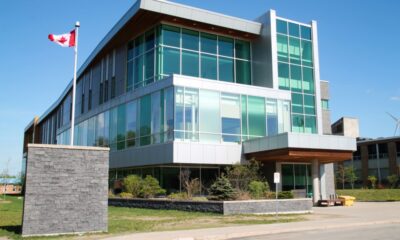Top Stories
Toronto’s Sidewalks Face Growing Chaos as Pedestrian Traffic Surges

The sidewalks of Toronto are increasingly becoming chaotic, as more pedestrians navigate crowded paths filled with obstacles such as delivery bikes, trash bins, and construction zones. Residents report that the situation has worsened significantly in recent years, raising concerns about safety and accessibility in Canada’s largest city.
According to urban planner Antonio Gómez-Palacio, the growing pressure on the city’s sidewalks stems from rising population density and more delivery vehicles vying for the same space. “We’re not really taking care of such a precious space, and a space of which we demand so much,” he remarked. The city’s sidewalks, originally designed for a smaller population, now struggle to accommodate the increasing foot traffic.
One local resident, Alex Smith, co-owner of an architectural rendering company, shared his frustrations: “The sidewalks have become overcrowded and much harder to navigate over the past few years.” He highlighted the challenges posed by delivery bikes weaving through crowds and the expansion of sidewalk patios that push pedestrians closer to traffic. Smith advocates for wider sidewalks, particularly on busy streets like King West and Yonge, where the number of pedestrians has significantly outstripped available space.
The issue is not confined to major thoroughfares. Liza Egbogah, a chiropractor, described a daily struggle while walking her son to school. “Every day is a new obstacle course,” she said, recalling instances of having to navigate around trucks parked on the sidewalks. Such experiences have become common, with pedestrians often forced to walk in traffic to bypass blockages.
Many residents believe the problem is exacerbated by poor pedestrian etiquette. Alice Wu, a visitor from St. Catharines, pointed out that groups often take up the full width of the sidewalk, making it difficult for faster walkers to pass. “Lately it’s gotten way worse,” she stated, emphasizing the challenges of navigating busy streets like Queen Street East.
The presence of cyclists on sidewalks adds another layer of complexity. Michael Longfield, executive director of the cycling advocacy organization Cycle Toronto, noted that cyclists often feel compelled to ride on sidewalks for safety, particularly on roads lacking proper bike lanes. Longfield explained that on roads with protected bike tracks, sidewalk cycling drops significantly.
For those with disabilities, the condition of Toronto’s sidewalks presents unique challenges. Content creator and motivational speaker Spencer West described the pavement as “chaotic” and “challenging,” highlighting uneven surfaces and blocked curb cutouts. “It takes me so much longer to get anywhere because I constantly have to pay attention,” he said. West underscored the importance of accessibility, advocating for wider sidewalks that can accommodate ramps for those in wheelchairs.
Amid these complaints, the City of Toronto is aware of the issues and is taking steps to address them. Laura McQuillan, senior communications advisor for the city, stated that Toronto spends approximately $18 million annually on permanent sidewalk repairs. The city also has several initiatives, including the Vision Zero Road Safety plan, aimed at improving pedestrian safety and reducing sidewalk closures during construction.
Despite these efforts, many residents feel that the maintenance and design of sidewalks need urgent attention. Gómez-Palacio emphasized the potential benefits of well-maintained sidewalks, suggesting that they could transform the urban experience. “Simply having beautiful, well-maintained sidewalks, getting some great trees in place,” he said, “is the easiest thing we can do to completely transform the perception of a city.”
As Toronto continues to evolve, the importance of addressing sidewalk conditions cannot be overstated. The experiences shared by residents highlight the need for a collective effort to ensure that these essential pathways remain safe and navigable for everyone.
-

 World3 months ago
World3 months agoScientists Unearth Ancient Antarctic Ice to Unlock Climate Secrets
-

 Entertainment3 months ago
Entertainment3 months agoTrump and McCormick to Announce $70 Billion Energy Investments
-

 Lifestyle3 months ago
Lifestyle3 months agoTransLink Launches Food Truck Program to Boost Revenue in Vancouver
-

 Science3 months ago
Science3 months agoFour Astronauts Return to Earth After International Space Station Mission
-

 Technology2 months ago
Technology2 months agoApple Notes Enhances Functionality with Markdown Support in macOS 26
-

 Top Stories1 week ago
Top Stories1 week agoUrgent Update: Fatal Crash on Highway 99 Claims Life of Pitt Meadows Man
-

 Sports3 months ago
Sports3 months agoSearch Underway for Missing Hunter Amid Hokkaido Bear Emergency
-

 Politics2 months ago
Politics2 months agoUkrainian Tennis Star Elina Svitolina Faces Death Threats Online
-

 Technology3 months ago
Technology3 months agoFrosthaven Launches Early Access on July 31, 2025
-

 Politics3 months ago
Politics3 months agoCarney Engages First Nations Leaders at Development Law Summit
-

 Entertainment3 months ago
Entertainment3 months agoCalgary Theatre Troupe Revives Magic at Winnipeg Fringe Festival
-

 Politics1 week ago
Politics1 week agoShutdown Reflects Democratic Struggles Amid Economic Concerns




















